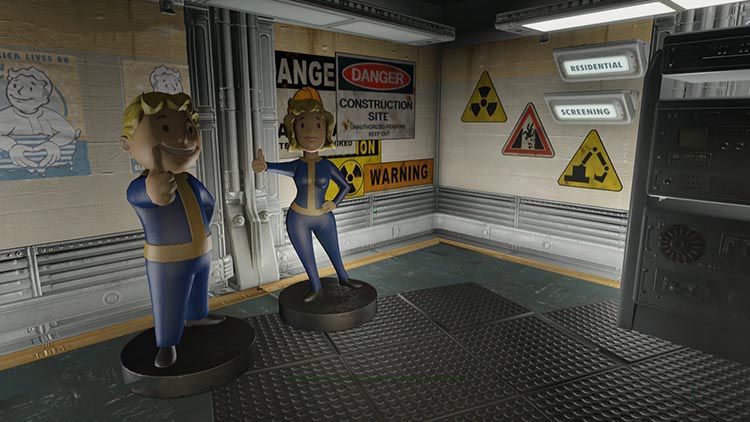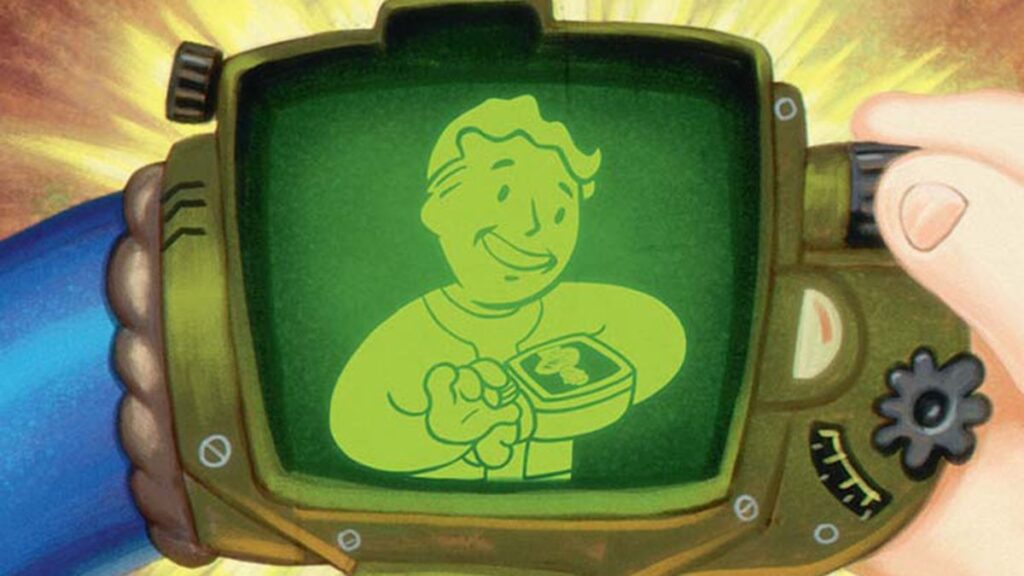“I’ve just taken a cyanide pill,” Siggi Wilzig (Michael Emerson) admits in episode 2 of Prime Video’s Fallout series. “Vault-Tec Plan D: It was the most humane product that Vault-Tec ever made.”
This thought sets up viewer expectations for what’s to come over the next few episodes — but for fans of the post-apocalyptic video game series, it’s a glib reminder of the fictional corporation’s heinous in-game history.
Vault-Tec built the bomb shelters, or Vaults, in the world of Fallout, purportedly as a cautionary measure to protect the American people in the event of a catastrophic incident. Funded by the government (“Project Safehouse”) and junk bonds, these underground bunkers featured highly advanced technology to create self-sufficient ecosystems completely independent of the outside world. Those who secured a spot in one of these shelters survived the nuclear holocaust, living comfortably within a small community governed by an Overseer and official Vault-Tec procedures.
At least, that was the promise Vault-Tec and the U.S. government sold to the American people. In reality, Vault-Tec had little interest in saving the population — its corporate leadership was playing the long game, using the majority of the Vaults to conduct social experiments and scientific research, free from the restraints of regulations or ethics. And with Prime Video’s Fallout, we get even more insight into how nefarious this company can be.
Where does Vault-Tec come from in Fallout?
Image: AKQA/Wizards of the Coast
Initially, Vault-Tec was essentially background decoration to enhance Fallout’s retrofuture setting. The company and its corporate mascot, Vault Boy, satirized the fiercely patriotic American pop culture that thrived during the Cold War — think the cheerful “Duck and Cover” PSA or the many examples of shocking print advertising. Many of the franchise’s most well-known emblems — the blue-and-yellow Vault suit, the Vault Boy mascot, and even the iconic gear-shaped Vault entrance — appear early in the first game as the player character (the Vault Dweller) is introduced to the world in a Vault-Tec Vault.
Fallout creator Timothy Cain has said that his goal was to make the player’s experience as immersive as possible, so even the physical packaging was designed to fit with the game’s setting. The manual, “Vault Dweller’s Survival Guide,” is written in the style of an official Vault-Tec document, providing the player with helpful information for its underground citizens. (The game manual references other fictional Vault-Tec documents to survive global disasters, like “How to Eat Rat” and “Coping with Mr. Virus!” — the latter hits differently in 2024.)
“The key to a successful reintroduction of civilization following a massive scale nuclear war is people,” the guide reads. “Here at Vault-Tec, we are working to ensure that your fellow man (and woman) is up to the task of bringing America back from the dead.”
Players learned more about Vault-Tec as a corporation as the games progressed, particularly in Fallout 3 and beyond, thanks to terminal entries and holotapes. The company cultivated an all-American image for the public, fostering a positive reputation through strategic marketing and branded promotional materials (like bobbleheads and lunchboxes — items Bethesda made into a reality). But behind closed doors, the company operated in an oppressive, draconian manner, treating employees more like a disposable resource than living beings — although, to be fair, this is par for the course for virtually every corporation in the Fallout universe.
Has Vault-Tec always been evil?

Fallout 2 expanded the Vault-Tec lore through the main storyline, giving the corporation a sinister covert motive. Black Isle Studios art director Leonard Boyarsky describes this process in a 2017 interview. “All during Fallout 1 we never ever talked about Vaults being anything but what they were,” says Boyarsky. Then, during a Fallout 2 development meeting, there was an idea to retcon them into social experiments — an idea he says “changed the trajectory” of the franchise.
Fallout 2 introduced the Enclave, the remnants of the prewar American deep state. Having survived the Great War, this mix of high-powered military, political, and corporate leadership continued operations underground, and over generations evolved into a paramilitary faction that viewed itself as the new political order, a cryptocracy destined to “cleanse” the Wasteland.
Near the game’s climax, Enclave President Dick Richardson reveals Vault-Tec’s involvement in the deep state. The Vaults were constructed as part of a “great plan,” but rather than save the American people, their true purpose was to be “a social experiment on a grand scale.” Without getting into specifics, he explains that many of the Vaults were designed to “test humanity.” Vault 13 — the Vault from the original game — was a control group, meant to house inhabitants underground until the Enclave needed fresh meat.
The official game guide for Fallout 3 is more upfront about Vault-Tec, characterizing the player’s home Vault as “an unscrupulous social experiment.” Players encounter several Vaults in the game, each with a unique backstory and challenges to overcome. Exploring these abandoned, often dangerous structures and discovering the nature of their failed “experiment” became a major part of the gameplay from this point forward.
Fallout: New Vegas, Fallout 4, and the MMORPG Fallout 76 all introduced new and original Vaults with creepy, tragic, and sometimes hilarious backstories, further growing Vault-Tec’s in-game history. The Vaults contain proprietary technology unparalleled anywhere else, and in some cases, a Vault’s experiment results in a significant scientific achievement — like Vault 81 developing a universal cure for disease. But the scientific progress came at a great human cost, and as we learn in Prime Video’s new show, this was by design.
We see some of this in episode 7, when Vault-Tec executives meet with representatives of RobCo, West Tek, Big MT, and Repconn — all big businesses with equally problematic histories in the games. The group discusses plans to divvy up the Vaults for experimentation, gleefully brainstorming cruel tests they could subject Vault Dwellers to. It’s shockingly inhumane, but exactly in line with what players know about how prewar corporations functioned.
[Ed. note: The rest of this article contains spoilers for a major twist at the end of Fallout season 1.]

Photo: JoJo Whilden/Prime Video
Why did Vault-Tec drop the bomb (if they did)?
In the prewar timeline, Moldaver and her NCR followers warn Cooper Howard that Vault-Tec, the company he’s aligned himself with, is more dangerous than he could possibly imagine. The company’s “fiduciary responsibility” means that these Vaults, which are immensely expensive to construct, need to pay off. Without a nuclear event, these highly advanced shelters serve no purpose.
The show seems to point to the answer to a question that has long puzzled gamers: Why did Vault-Tec invest so heavily in social experiments? Turns out, it was for the benefit of its corporate partners, who are almost certainly involved in founding the Enclave (Barb looking up a shadowy figure certainly implies as much). Although it’s not yet clear how, the show reveals that Vault-Tec had enough power and influence to set off nuclear devastation. Suddenly the vaults make a lot more sense; the shadow government had a vested interest in ending the world so it could conduct its experiments and outlive the competition.
Leveling the outside world, waiting for the dust to clear, then recreating the world as it sees fit — this is how Vault-Tec plans to “bring America back from the dead.”
The core rulebook for Modiphius’ 2d20 Fallout role-playing game dedicates an entire chapter to establishing Vault-Tec and Vault lore. The opening paragraphs sum up the corporation’s core contradiction nicely:
If not for the protection of their core product line, it’s questionable whether any recognizable fragment of humanity would have survived to repopulate the Wasteland. Through their craftsmanship and proprietary technology, they saved the human species.
That said, what lurks in some of their vaults – be it technology, biological experiments gone bad, or simply humanity turned feral over decades in the dark–represent the most dangerous threats to humanity’s survival.
They say you can’t have it both ways. Vault-Tec proved them wrong.

